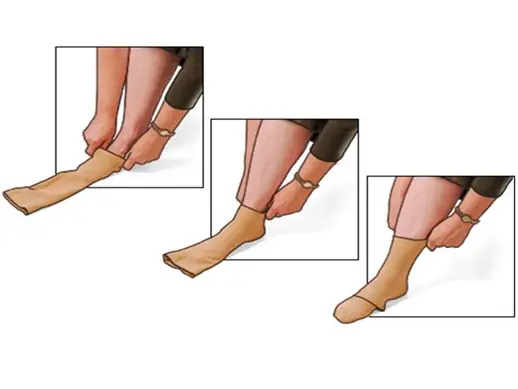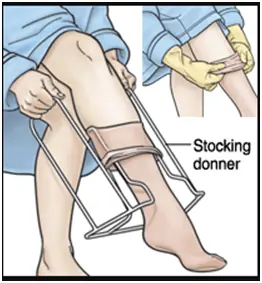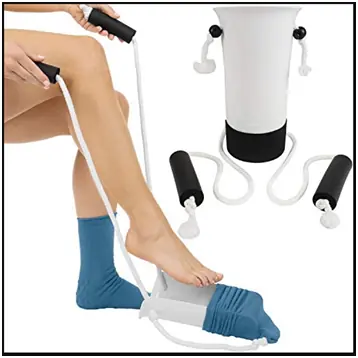Compression stockings are commonly used for their many health benefits. They can help improve blood flow and reduce swelling that often occurs with chronic venous insufficiency, lymphedema, varicose veins, and deep vein thrombosis (DVT), to name a few of their uses.
If you have issues putting on regular socks or stockings due to arthritis or other issues, compression stockings might prove even more challenging.
Fortunately, there are several techniques that can make this process easier. Below are tips for you if you don’t know how to put on compression stockings along with images that may help you get the best job done.
Health Benefits of Compression Stockings
Compression stockings are designed to help reduce the risk of deep vein thrombosis, post-thrombotic syndrome, and blood clots forming in the legs.
They also help with:
Smooth circulation of blood – stockings balance the flow of blood in calves and avoid it to become a thrombus. It, therefore, maintains a smooth circulation of blood throughout your walk!
Read: How To Choose The Best Compression Socks – Ultimate Guide
5 Effortless Ways for Wearing Compression Stockings:
Put the sock over your hand and guide it up to your leg.

First, put your hand into the sock and guide it up to your leg, making sure to insert your foot through the opening at the bottom of the sock.
Secondly, pull the sock over your heel, ensuring that it doesn’t twist around in its journey up your leg.
Carefully pull the shoe over each toe until it is snug. If your shoe has a small opening, pull down on the top of your foot to create more space. Slide your toes into the shoe without ripping any skin.
Use your other fingers to pull the sock upwards

You can also use your other hand to pull the sock up, or both hands – or even the heel of your hand. It’s not uncommon to use all four fingers to grab hold of a compression stocking and pull it up.
Using just one finger is not a great idea though because you won’t have enough leverage. Your toes are another good option if you have some free time on your hands (pun intended).
You can use a sock aid if you prefer

You can put on your compression stockings with the help of a sock aid, which is a device that allows you to easily put on your compression stockings.
A sock aid is generally shaped like an open-ended tube with handles at each end. You simply slide it over your foot and then place one end inside the top of the stocking, holding it in place while you pull the stocking down over your foot.
The easiest way to choose a sock aid is by asking yourself: do I have trouble putting on my own socks? If so, then this tool will give you some independence back. It’s also helpful if someone needs to dress you or help get dressed—they can use this tool without any problem too!
A short sock or stocking donner is also useful
A short sock or stocking donner is also useful. It’s a tube that makes it easier to get compression stockings on and off. You can find these at medical supply stores, but you can use a sheet or long pillowcase as a makeshift donner as well.

To put on your compression stockings:
- Adjust the donner: Before filling the donner with your sock, slide it over your foot and up to just below your knee (if you have ankle support).
- Fill the donner: Fill it with one leg of your stockings until it reaches just below where that leg will be when worn (between mid-thigh and knee). If using two legs of stockings, fill each leg separately so that they’re not tangled together when put on later!
- Wind up the process: Remove the donner from one foot and pull one end of the stocking through its hole; this will prevent any bunching up around your toes once everything is in place! Repeat with other foot/legs if use.
use a sheet or long pillowcase as a makeshift donner

If you are unable to purchase a donner, or if you prefer to use your own method, you can use a sheet or long pillowcase.
To use the sheet/pillowcase method:
- Put on your compression stocking with one hand while holding the top of it with your other hand.
- Roll up the bottom half of the leg from ankle to just below mid-calf (If you have extra length at this point, fold it over.) Do not roll off any toe length yet!
4 Useful Aid For Compression Socks For Easy Wearing
You know you need to wear compression stockings for your workout, but getting them on is just a bit too far out of reach. You are feeling frustrated and find yourself in a tricky spot and you have no options.
Well, have no fear! There are many products available that can help you get those compression stockings on by yourself. Here are some tools that can aid with compression stockings and you would admire the way they work for you!
Dressing Stick

The best way to help you put on your compression socks is through a dressing stick.
A dressing stick is a tool that helps people put on and take off compression socks. It is available in multiple sizes and can be used by people with arthritis or limited mobility. The dressing stick helps support the weight of the sock as you lift up your leg, making it easier to put on and take off.
Long Handled Shoehorn

A shoehorn is a tool that helps you put on your shoes. It has a long handle with a curved end that fits into the back of your shoe. You can use the shoehorn to pry open the shoe and slide your foot in more easily. Shoehorns are made of wood, plastic, or metal and can be found in most department stores. They are relatively inexpensive, costing between $10 and $20.
Compression Stocking Heel Aid Donner

The heel aid donner helps people with diabetes and peripheral vascular disease put on and take off compression stockings more easily. It consists of a plastic handle and a rubberized ring with Velcro straps. The ring fits over the top of the foot and grips tightly against the leg, making it easier to put on and take off compression stockings.
Compression Stocking Remover
When it comes to removing your socks, the best aid for compression stockings is by using a stocking remover.
A compression stocking remover is a device that helps you remove your compression stockings without causing any pain or irritation. It’s also very easy to use and can be used by anyone even if they’re disabled or elderly.
What Are The Reasons That Putting on Compression Socks Is Harder?
You’re not alone if you have a hard time putting on compression stockings, socks, or slippers. The most common complaints include the following:
Other Options To Aid For Putting On Compression Socks
There are many options to help you get your compression stockings on and off without assistance. Some people find that using a shoehorn or other long, sturdy rod helps them to slip their compression socks on easily.
If this sounds like it would be helpful for you, try looking around for one at the local drugstore or hardware store.
Another option is a sock aid. Sock aids are devices that make it easier to put on socks by yourself. They come in a variety of shapes and sizes, and some even have grips to help you pull up your socks. If you need help putting on compression garments, there are braces available online that will hold up your stockings in place. These devices are often less expensive on store’s like Amazon, than buying them from a doctor’s office.
What preventive measures should I take while wearing compression stockings?
Tip!
Compression Socks Are Usually Easier To Put On When You’re Lying Down.
You can put on compression socks by lying down and putting one foot up on the bed or chair. You can then pull the sock up to your knee. Repeat with the other leg.
You can also sit on the edge of a chair, bring one leg up so that it’s bent at about a 90-degree angle, and pull the sock over that foot while keeping your heel in place with one hand. Then repeat with the other leg!
Also Read Our Compression Socks Reviews & Buying Guide:
FAQs – Get more hints, more ways!
If you’re going to be traveling anywhere, especially if you’ll be on an aeroplane or in an airport for any length of time, look for a pair of compression socks that are designed specifically for travel. These will be lightweight and easy to carry around without adding bulk or baggage fees to your trip!
If you’re just looking for some extra support while recovering from an injury or surgery (and aren’t suffering from anything serious), then wearing them for long periods doesn’t make sense. Especially because they can cause skin irritation and even allergic reactions over time if worn too often.
The answer to this question depends on your needs and how much help you need. If you’re looking for an alternative to compression stockings, a compression stocking aid may be right for you. You can also use some of these aids as alternatives to knee braces, which are often used by people with arthritis in their knees and legs.
The heel aid donner is the best compression stocking aid for elderly people because it’s designed with your needs in mind. It has an ergonomic handle that makes it easy to use, even if you have limited mobility. The handle allows you to hold onto your socks while you put them on, so you don’t have to worry about dropping them or struggling with them when putting them on.
If you want something even easier than a dressing stick for getting into those tight-fitting socks, try getting some nylon tights instead. They’ll fit like a second skin but won’t cost nearly as much money as full-on compression garments as leggings or tights do!
Conclusion
There are many different types of sock aids on the market. We have narrowed down our top three based on their functionality and ease of use. These tools are reliable, handy, convenient, and affordable. You can choose the best one according to your health circumstances.
We hope this guide has been helpful. Giving yourself a leg massage while wearing compression stockings can help break up scar tissue and make your legs feel better overall.
If you want advice about how long you should wear compression stockings or what size would be best suited to your needs, then consult with a medical professional before making any purchases.


